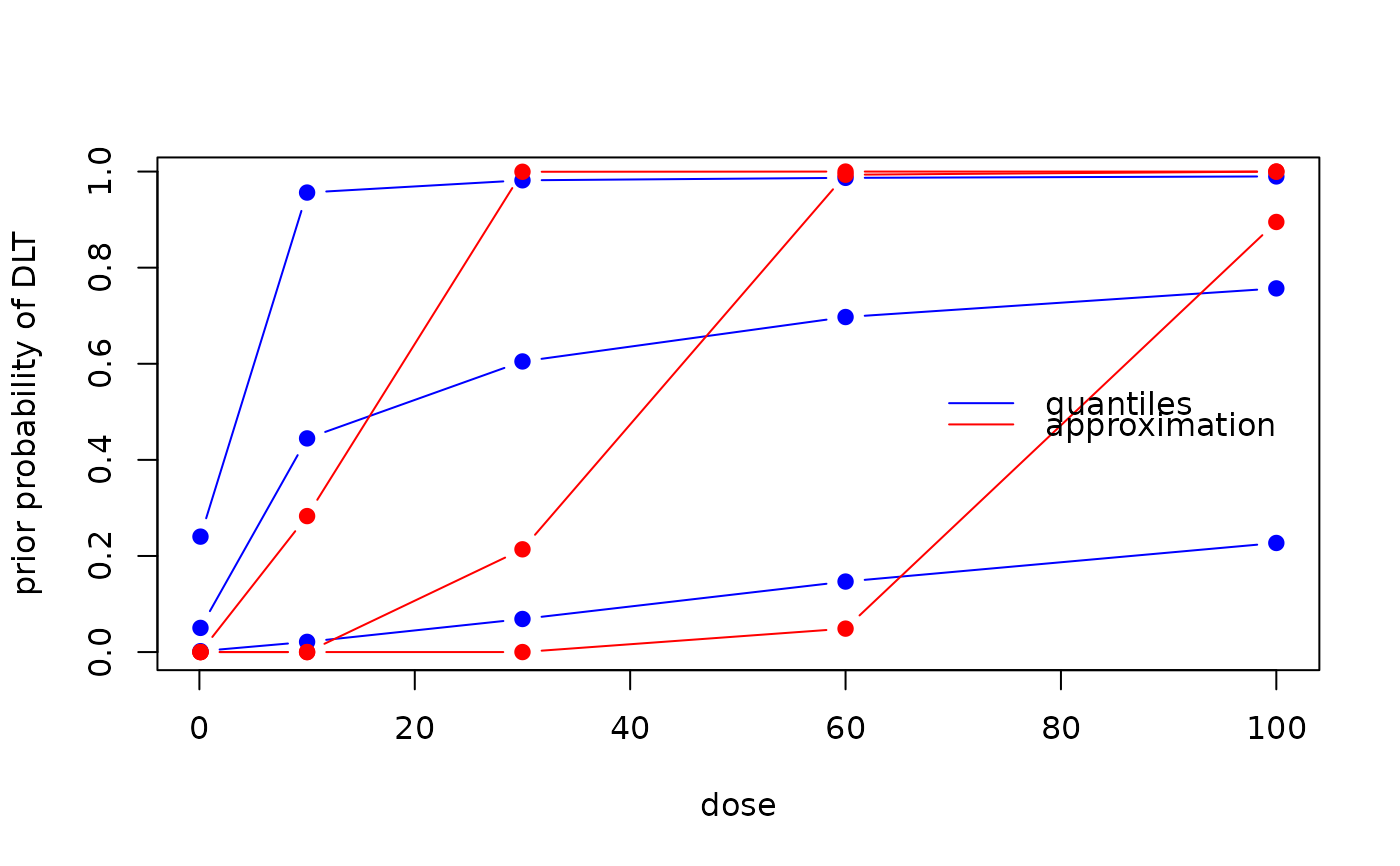This function constructs a minimally informative prior, which is captured in
a LogisticNormal (or LogisticLogNormal) object.
Based on the proposal by Neuenschwander et al. (2008)
,
a minimally informative prior distribution is constructed. The
required key input is the minimum (\(d_{1}\) in the notation of the
Appendix A.1 of that paper) and the maximum value (\(d_{J}\)) of the dose
grid supplied to this function. Then threshmin is the probability
threshold \(q_{1}\), such that any probability of DLT larger than
\(q_{1}\) has only 5% probability. Therefore \(q_{1}\) is the 95%
quantile of the beta distribution and hence \(p_{1} = 0.95\). Likewise,
threshmax is the probability threshold \(q_{J}\), such that any
probability of DLT smaller than \(q_{J}\) has only 5% probability
(\(p_{J} = 0.05\)). The probabilities \(1 - p_{1}\) and \(p_{J}\) can be
controlled with the arguments probmin and probmax, respectively.
Subsequently, for all doses supplied in the
dosegrid argument, beta distributions are set up from the assumption
that the prior medians are linear in log-dose on the logit scale, and
Quantiles2LogisticNormal() is used to transform the resulting
quantiles into an approximating LogisticNormal (or
LogisticLogNormal) model. Note that the reference dose
is not required for these computations.
Usage
MinimalInformative(
dosegrid,
refDose,
threshmin = 0.2,
threshmax = 0.3,
probmin = 0.05,
probmax = 0.05,
...
)Arguments
- dosegrid
(
numeric)
the dose grid.- refDose
(
number)
the reference dose.- threshmin
(
number)
any toxicity probability above this threshold would be very unlikely (seeprobmin) at the minimum dose.- threshmax
(
number)
any toxicity probability below this threshold would be very unlikely (seeprobmax) at the maximum dose.- probmin
(
number)
the prior probability of exceedingthreshminat the minimum dose.- probmax
(
number)
the prior probability of being belowthreshmaxat the maximum dose.- ...
additional arguments for computations, see
Quantiles2LogisticNormal(), e.g.refDoseandlogNormal=TRUEto obtain a minimal informative log normal prior.
References
Neuenschwander B, Branson M, Gsponer T (2008). “Critical aspects of the Bayesian approach to phase I cancer trials.” Statistics in Medicine, 27(13), 2420–2439. https://onlinelibrary.wiley.com/doi/10.1002/sim.3230.
Examples
# \donttest{
# Setting up a minimal informative prior
# max.time is quite small only for the purpose of showing the example. They
# should be increased for a real case.
set.seed(132)
coarseGrid <- c(0.1, 10, 30, 60, 100)
minInfModel <- MinimalInformative(dosegrid = coarseGrid,
refDose=50,
threshmin=0.2,
threshmax=0.3,
control=## for real case: leave out control
list(max.time=0.1))
#> It: 1, obj value (lsEnd): 0.6732911061 indTrace: 1
#> timeSpan = 4.464847 maxTime = 0.1
#> Emini is: 0.6732911061
#> xmini are:
#> 3.436837973 9.074768474 4.306636605 0.7253533934 -0.7572128108
#> Totally it used 4.464881 secs
#> No. of function call is: 991
# Plotting the result
matplot(x=coarseGrid,
y=minInfModel$required,
type="b", pch=19, col="blue", lty=1,
xlab="dose",
ylab="prior probability of DLT")
matlines(x=coarseGrid,
y=minInfModel$quantiles,
type="b", pch=19, col="red", lty=1)
legend("right",
legend=c("quantiles", "approximation"),
col=c("blue", "red"),
lty=1,
bty="n")
 # }
# }
